



Sconces are wall-mounted fixtures that bring directional and ambient light to hallways, bathrooms, exterior entryways, offices, and other spaces throughout the home. These fixtures can be found in any room or setting where added illumination or softened lighting is desired. While all sconces share common design elements, the look and application of these lights can vary greatly. We recommend pairing wall sconces with general overhead and task lighting to fully illuminate a space.
Most wall sconces share common design elements. These types of lights can be crafted from a variety of materials, from bronze to brass, and generally include a shade crafted from metal, fabric, or glass. Owing to their prominent, eye-level placement, sconces are oftentimes highly decorative and intended to make a strong decorative statement in any setting. Outdoor wall sconces will be crafted from weather-resistant metals, glass, or marine-grade plastic. Common components of sconces include:
Sconces typically use LED, incandescent, or fluorescent bulbs. Wall sconces rarely include exposed bulbs (except in the case of candle sconces) and the aesthetic of the bulb is rarely a consideration. The size and design of the sconce will determine its bulb compatibility. Each bulb type has unique qualities and advantages.
Indoor wall sconces can be powered by batteries, wall plug-ins, or hard wiring. Hard-wired wall sconces are typically run on a line voltage or high voltage system (defined at 120 volts). Outdoor wall sconces will generally be low voltage, and require low voltage wiring and a transformer pack to operate. Indoor wall sconces may be low voltage in cases where small or speciality bulbs are used, because low voltage lighting systems allow for a wider range of bulb sizes and types. Each power system has unique benefits and deterrents.
Note: Always consult a professional lighting electrication before purchasing or installing any lighting system. This guide is not intended to take the place of a professional's best opinion or serve as a technical safety manual.
Low voltage lighting systems are defined at 10V, 12V or 24V. Low voltage fixtures generally include outdoor lighting systems and indoor fixtures with specialty or small bulbs. Low voltage lights require the use of a low voltage electrical cable and transformer pack to operate correctly.
Line voltage or high voltage systems are the default wiring voltage for most home interiors. High voltage fixtures do not require any special equipment or transformers to operate. Line voltage lights are the most popular option in indoor settings.
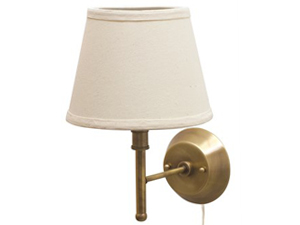
The most common type of wall sconce features a single bulb and shade. These types of sconces can be made from any standard fixture material, and popular shade materials are fabric, metal and glass. When picturing a standard wall sconce, many people tend to imagine a ornamented, highly-decorative fixture. While traditional styles are popular, more sleek, modern options are also available. Wall sconce shades are generally open at one end (the top or bottom) or open at both the top and bottom. The orientation of the shade will determine if the sconce uplights, downlights, or simultaneously uplights and downlights the corresponding wall and surrounding area. Some glass sconce shades are opaque and completely closed, and emit general, ambient light as opposed to directed light. Most standard wall sconces are hard-wired to a junction boxes along a wall surface, though standard wall sconces can include an integrated on/off switch.
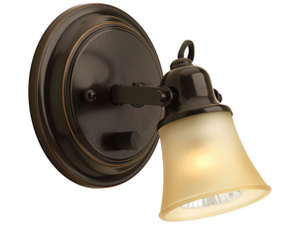
Directional wall sconces resemble standard wall sconces, however their design includes a discrete hinged component. The hinge makes these sconces easily adjustable, and allows for spotlighting of specific artwork or features throughout a room.
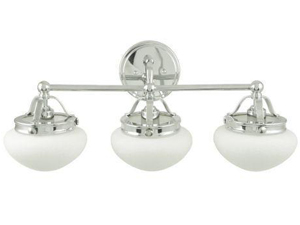
Multi-light sconces include multiple bulbs and shades in their design. These types of sconces are commonly found in bathrooms, kitchens, and other spaces throughout the home where more dimensional, dynamic lighting is desired. Multi-light sconces typically include two bulbs and shades that symmetrically extend from the central arm or back plate, but they can include any number lights in their design.

Candle wall sconces are intended to imitate the look of genuine flame fixtures, popular in Europe throughout the 19th century. These sconces have a decidedly antique look, and usually do not include shades to highlight the appearance of the candle-flame light bulbs. Candle flame sconces can include one, two, or more bulbs.
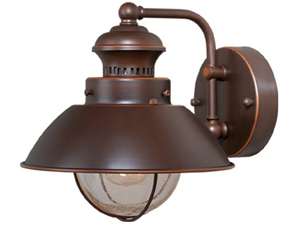
Outdoor wall sconces share many components with indoor wall sconces, and are made from weather-graded materials (such as powdered metal or durable plastic) to prevent damage from rain, wind, and snow. Outdoor sconces generally include a framed decorative housing for the bulb(s) with glass panels that fully encase the fixture to prevent water or leaves from accumulating within the fixture. Outdoor wall sconces are typically low voltage, and may include features such as automatic shut off and motion sensors. Outdoor sconces illuminate hazardous and eliminate shadows along walkways, paths, and add to exterior home appeal. They are oftentimes used to illuminate a front entryway or spotlight house numbers.
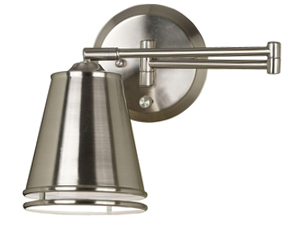
Swing arm sconces include a hinged, extendable arm. Contrary to directional sconces, which can only be adjusted up and down or side to side, these lights offer much more freedom of adjustability. Wall swing arm sconces can typically be moved closer to the wall or further away and be rotated for effective task lighting. Swing arm sconces are popular in reading nooks and by bedsides in rooms that are too small to accommodate a nightstand. On/off switches and integrated dimmers are popular features in swing arm sconce design.
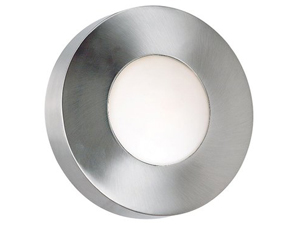
Flush mount wall sconces do not have an extended arm, but are instead mounted flush against the wall surface. Flush mount sconces are fully encased, and usually have an opaque glass surface that emits diffused light. These types of lights are ideal in narrow hallways, and generally carry a more relaxed appearance than traditional arm sconces. Flush mount sconces provide general illumination as opposed to ambient, directional light.
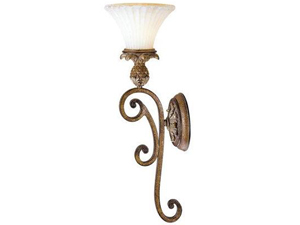
Wallchieres mimic the look of original wall-mount torches, which were real flame torches that could be set into permanent stands attached to walls or removed and used as a portable light source. These lights combine the modern functionality of a wall sconce with the appearance of a stand-alone torch. Wallchieres cast soft, upwards light, and both modern and traditional wallchieres are available.
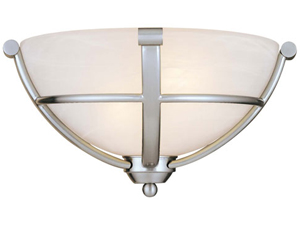
Half moon sconces closely resemble flush mount sconces, with the addition of an open top that casts light upwards. These sconces are a popular option because the cast diffused general light as well as upwards light.
Contemporary fixtures feature sleek lines and straight-forward styling. Geometric shapes, clean finishes, and modern glass are trademark indicators of the contemporary look.
Transitional lights bridge the gap between traditional and contemporary styles, lifting elements from both new and timeless design for a unique aesthetic. These fixtures may include sleek lines with some decorative ornamentation, elegant curved frames, and light detailing.
Traditional fixtures draw upon time-honored motifs for their design. Traditional lights are highly ornamental, and may recall a vintage European aesthetic. Popular features in traditional design include frosted glass, curved frames, and antiqued bronze finishes.
Popular in country or quaint home design, rustic lighting integrates organic shapes, textures, and weathering for a warm, relaxed look with regained modern appeal.
Craftsman lighting design mimics craftsman home design. Straight, simple lines, sharp angles, and contemporary materials are indicators of the craftsman style. Craftsman lights incorporate artistic hand-made style elements, such as painted finishings and seeded glass.
Contemporary industrial style mimics turn-of-the-century factory design, for a gritty, urban look. These lights use patinaed metals, vintage bulbs, and reclaimed motifs to achieve their signature aesthetic.
Wall sconces vary in terms of size, but generally fall between 4”-20” wide. Sconces used for task lighting purposes should be proportional to the object they are illuminating. For example, sconces alongside a small bathroom mirror should be smaller in size, while sconces illuminating a tall outdoor entryway should be larger.
Ideal sconce platement depends on the size and type of the fixture, application, room size, and proportional size of the item being illuminated, among other factors.



